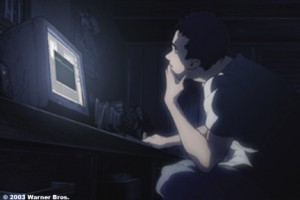
MATRIX: Shinichiro Watanabe and yourself shot some digital video of Clayton Watson for KID’S STORY, which Watanabe-san is directing; could you describe why you did that.
MIKE: Clayton Watson, who plays the Kid, is the central character in the KID’S STORY ANIMATRIX episode that Watanabe-san is directing. First of all we shot Clayton with a regular home video set up, just to capture his facial expressions as he reads the dialogue that’s actually planned for the KID’S STORY. He sort of expanded off it and gave us several different readings of each line, so it’s going to be very useful reference for the guys drawing key frames to get those facial nuances, which you have to see in motion to appreciate. You can’t just look at a picture of someone smiling or frowning, you want to actually see them go between expressions because it’s so different seeing a person animated.
MATRIX: The KID’S STORY script calls for the Kid to drop a cell phone as well; did you film Clayton doing that for similar reasons?
MIKE: Yes. As long as we’re going to animate this character, which we want to seem like the same character, the same Kid who is in THE MATRIX 2 and THE MATRIX 3, it’s only going to make a more convincing illusion the more the animation resembles the real Kid. There are obviously some things, like expressions and motions, which tend to get exaggerated and timed differently in animation, because it has more of an impact that way. Someone doesn’t just reach for a glass, they reach for a glass. There’s a very different acceleration and deceleration you see in cel animation that is exciting to the eye, it’s more pleasurable, which is something you don’t have in live action. Although, in THE MATRIX movies, a lot of the special effects definitely have that in mind, all the fight scenes feel like they could be hand drawn.
Andy and Larry are probably very influenced by animation, in that respect anyway. They definitely have a sense of the way that motion can feel good and can actually be pleasurable to watch. It’s not just watching people move, it’s watching these people move in a certain way, it’s very orchestrated, and we, as animators, have to go through the same process. We’re not using Clayton’s motions as is, we’re not tracing them or anything, but they’re very useful as a guide. Shooting the reference video means that he’ll be that much more recognizably the Kid in the anime.
MATRIX: Will you be using Clayton Watson’s voice as the Kid in the anime itself?
MIKE: Yes, Clayton himself is going to speak the dialogue and the various voice over parts for the Kid. That is essential because it’s the first thing that tells you the anime character is the same person. Besides it just looking like the same person, the anime character has to have the same voice. It will definitely be an important part of the performance, Clayton has a particular delivery style that we want to capture.
MIKE: We did something similar to what you do for a live action movie, a location hunt. Watanabe-san is from Japan, so he doesn’t have knowledge of what an American high school or a high school in everytown USA looks like. They have different desks in Japan, it’s a different style of schooling. One of the first things we did on the project was arrange for Watanabe-san and one of the graphic artists we’re working with, to actually tour a couple of high schools close to THE MATRIX location in Alameda. We went to Alameda High School and also Berkeley High School.
A good friend of mine from school is the Vice Principal of Alameda High School, we’ve actually based the character of the teacher in the Kid’s Story on this guy as well. He arranged for us to have free reign at Alameda High School and go to Berkeley High School, which is a much bigger school. Watanabe-san and the other artist, Hashimoto-san really got to absorb what makes an American High School look like an American High School, because there are some very particular things: the acoustic tile in the ceiling, the fluorescent lights, the tiles on the floor, the lockers, the desks, the chairs, those hideous plastic chairs from the seventies, it will all be in the anime. I think we’ll have a very realistic, but at the same time a very general, picture. It can’t look like just one school in particular, it has to be part of THE MATRIX.
MATRIX: Watanabe-san worked with a particular composer for Cowboy Bebop, will he be working with the same composer for this ANIMATRIX episode?
MIKE: Yoko Kano is the composer for Cowboy Bebop, I would love to get her for THE ANIMATRIX, but I’m not sure yet if that’s a possibility. She’s a good friend of mine as well and she’s a wonderful, wonderful composer. She’s done a lot of amazing animation sound tracks, work on Memories, Cowboy Bebop, Macross, she’s all over the place and is really good, but yet to be discovered in the United States.
MATRIX: Thanks Mike.
Interview by REDPILL
November 2001
